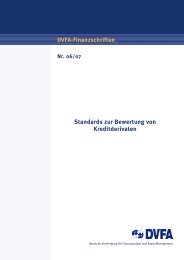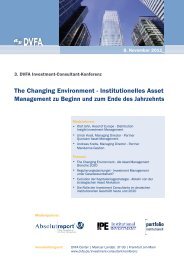KPIs for ESG - DVFA
KPIs for ESG - DVFA
KPIs for ESG - DVFA
You also want an ePaper? Increase the reach of your titles
YUMPU automatically turns print PDFs into web optimized ePapers that Google loves.
5. Consolidation of data<br />
It is not uncommon that the basis of consolidation <strong>for</strong> financial and <strong>ESG</strong> data differ both geographically and segmentwise.<br />
There may be several reasons to explain this phenomenon and indeed there may even be good reason <strong>for</strong> a<br />
corporate to exclude geographic areas or business units, e.g. when data quality <strong>for</strong> these markets is low or assurance<br />
cannot be obtained.<br />
However, rigorous investment analysis requires that financial per<strong>for</strong>mance data relate with <strong>ESG</strong> data to the end of<br />
peer-group or cross-industry comparison.<br />
Companies should provide a statement as to the basis of consolidation of their <strong>ESG</strong> data which specifies and names<br />
the markets, geographical areas, products, segments etc. that have been excluded from consolidation. Should bases<br />
<strong>for</strong> consolidation vary between different <strong>ESG</strong>s, corporates should provide details in the <strong>ESG</strong>-specific annotation.<br />
6. Benchmarks<br />
Some of our <strong>KPIs</strong> specifically depict relational per<strong>for</strong>mance, e.g. of a specific indicator related to sales, output or<br />
earnings.<br />
There can be no clear rule as to which benchmark is superior to another. Sales/revenues e.g. is indicative of the size of<br />
a company and, thus, any <strong>ESG</strong> per<strong>for</strong>mance related to revenues helps to provide perspective <strong>for</strong> comparison of<br />
corporates of different sizes. However, benchmarking against earnings ratios such as EBIT or EBITDA is often used to<br />
neutralize structural differences due to the consolidation of revenues from different markets. Finally, <strong>for</strong> a few<br />
subsectors, there are commonly reported and used benchmarks such as metric tonne, kWh, available shopping space<br />
in square metres/foot or simply units produced.<br />
A corporate should provide a table of relevant benchmarks that investment professionals can use <strong>for</strong> comparison and<br />
analysis at their discretion and based on their preferences. As a minimum the table should include 1. revenues, 2.<br />
EBIT, 3. EBITDA, as well as those generally accepted and used non-financial benchmarks common <strong>for</strong> an industry.<br />
Additionally, because investment analysis requires comparability of data and line items, i.e. users want to a) compare<br />
corporate per<strong>for</strong>mance within a reported period to prior periods and b) compare line items of a corporate to an<br />
external benchmark such as a typical industry average:<br />
It is recommended that corporates report both line items and relational benchmarks, which can consist of sectorrelated<br />
averages, data from peers or any other external reference point that serves to put individual corporate<br />
per<strong>for</strong>mance into context.<br />
© <strong>DVFA</strong> April 2010 ALL RIGHTS RESERVED. No part of this publication may be reproduced, stored in a retrieval system, or transmitted, in any <strong>for</strong>m or by any<br />
means, electronic, mechanical, recording, without the prior permission of the copyright holder.<br />
12

















